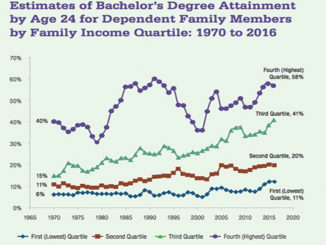
by Alex Gonzalez
Today, The Supreme Court again decided to hear the case that seeks to end the use of race as a determining factor when seeking admission to the University of Texas.
The controversy started when a white applicant was denied admission to the University in 2008. In her lawsuit the Abigail Fisher, the white student, alleges that her academic credentials were superior to many African-American and Latinos candidates who were admitted after receiving preferential consideration because they were deemed to be “underrepresented minorities.” However, attorneys for the University of Texas, including Texas Attorney General Greg Abbott on behalf of Texas, have advised The Court to refrain from hearing the case. They defend the University’s use of race in considering admission applications, saying it is narrowly tailored (which is the test used when there is a claim to laws being unconstitutional and discriminatory) to help the University achieve a critical level of diversity.
The decision of this case has bigger implications and repercussions that are more important to the state of Texas than the simple accusation of “preferential” treatment. Notwithstanding that the Top Ten Percent Plan is based on merits– academic achievement—not on race or “preferential” treatment. The policy needs to be left intact and further increased to woo Latinos into higher education institutions. Moreover, the Republican Legislature in Texas is aware of the disparities, which is why Republican politicians have promoted this policy since George W. Bush was Governor, and when Perry took over as Governor.
Conservatives assume that since Justice Samuel Alito has replaced Justice O’Connor (who oftentimes ruled center/left) they can halt Affirmative Action at the federal level, or in Texas in this case. However, in Texas a conservative state, Republican legislators are correctly enacting laws to entice Latinos into higher learning institutions so as to keep the future of the state economically strong by investing in future generations, as it was the case with Top Ten Percent Plan and in-state tuition for undocumented students .
Consequently, in Texas, these higher education policies are not about “diversity” and affirmative Action, but rather as tools that will help to prepare the large bloc of Latinos to become high-income earners and tax payers. Economically speaking, these type of policies like the “Top Ten Plan” are not policies born out the need for diversity but out of necessity; hence, the State and Republican legislators enacted laws that are intended to do something for the future of Texas. And, this is evident in the UT system.
For example, The Texas Top Ten Percent Plan significantly boosted the level of minority enrollment at UT without any reliance on race as a factor in admissions. In fact, by 2004, The University says its use of race as a selection criteria was not necessary to achieve its goal of increasing the minority student population to be close to equally represent that population in Texas. Race has not been a factor in the admission process in years, but rather scholastic merit was considered. But, although race has not been part of UT admission process in the past years, and are based on merits under the “Ten Percent Plan,” Latinos are still largely proportionally unrepresented in higher education. Currently, the percentage of Latinos attending the University of Texas is only 21% while the total population in the state is 37%. Yet they are more than ½ of the population of the students enrolled in K-12 programs.
Moreover, a majority of Latinos come from poor school districts–especially in the South where the number of Latino students have doubled since 2000. Consequently, salaries are only 2/3 of the average Texas salary in this region. Thus, this proves that there is a large generational gap in Texas between “Anglos” and Latinos that can be remedied with the programs that promote higher education policies for Latinos. In turn, these policies serve to strengthen the ties that colleges have with elementary and secondary schools and broadened access to the state’s most competitive public universities. Therefore, it is in the best interest to invest in a culture of high achievement, high income earning potential, which in turn will result in more revenue for the state in the long run.
What is the Texas Top Ten Percent Plan?
The Top 10% Law (originally styled “Texas House Bill 588”) was passed in 1997 and went into effect the following year. The law was a response to the Hopwood decision, in which the U.S. Court of Appeals for the Fifth Circuit prohibited public universities from using a student’s racial or ethnic background as a consideration for admission Under the law, high school students who graduate in the top 10 %of their high school class are guaranteed automatic admission to any public university in Texas, including UT Austin and Texas A&M in College Station .
“The top 10% admissions standard, which guarantees those who graduate in the top 10% of their high school class admission to the public Texas university of their choice.” Supporters of the 10% plan have emphasized that it has helped to create a more diverse freshman classes, both racially and geographically, at the University of Texas at Austin and at Texas A&M University at College Station – the two selective public institutions that considered race in admissions before Hopwood.
The Law’s proponents say it also has strengthened colleges’ ties with elementary and secondary schools and broadened access to the state’s most competitive public universities.
Top-10 students have been academically successful, performing as well as others who scored significantly higher on standardized college -entrance tests. But opposition to the10 –Percent plan is mounting, especially from vocal parents of students in the highly competitive affluent high schools — those several dozen public high schools, out of more than 1,000 in the state, with strong traditions of sending graduates to the state’s public flagships. Such parents, along with parents of students who score just below the top 10 %, or alumni whose families represent legacies at those institutions, complain that students automatically accepted through the plan are saturating the flagship campuses and limiting the flexibility to achieve diverse student bodies in the broadest sense.
 Almost 70 % of the students in UT Austin’s 2003 freshman class were top -10 percenters –and thus automatically admitted compared with only 42 % of those who enrolled in 1996, when a race – sensitive admissions policy was in effect. As a result, the critics contend, that seniors who attend demanding high schools and graduate just below the 10-% threshold are being unfairly rejected — “crowded out” by high ranked students from less – competitive high schools.
Almost 70 % of the students in UT Austin’s 2003 freshman class were top -10 percenters –and thus automatically admitted compared with only 42 % of those who enrolled in 1996, when a race – sensitive admissions policy was in effect. As a result, the critics contend, that seniors who attend demanding high schools and graduate just below the 10-% threshold are being unfairly rejected — “crowded out” by high ranked students from less – competitive high schools.
 The 2010 U.S. Census shows that Latinos are disproportionally underrepresented in Higher education and high-income jobs because of an age gap. Of the 25,145,561 people counted in Texas in the 2010 Census, 37.6 % were
The 2010 U.S. Census shows that Latinos are disproportionally underrepresented in Higher education and high-income jobs because of an age gap. Of the 25,145,561 people counted in Texas in the 2010 Census, 37.6 % were
Latinos and 45.3 % were non-Latinos whites. Yet Latinos disproportionately fill the ranks of younger Texans. Latinos comprise 48.3 % of Texans under the age of 18, up from 40.5 % in 2000.
Thus, the demographic trends of Texas pose an even greater challenge to UT’s capacity than the Affirmative Action policies. Consequently, rather than cutting programs like Top Ten, The UT needs to expand its campuses to accommodate a large generations of Latinos Texans who need to be educated in the next 10 years. The number of Texas high school graduates will rise by more than 20% by 2014-15. This demonstrates that Texas is one of the fastest growing states.
 This growth will produce 55,000 more high school graduates than in 2007. Very soon, the number of top 10% students alone will overwhelm the capacity of UT’s freshman class.
This growth will produce 55,000 more high school graduates than in 2007. Very soon, the number of top 10% students alone will overwhelm the capacity of UT’s freshman class.
Currently, there are an estimated 27,000 Top 10% graduates in Texas who are entitled to join UT’s freshman class of 6,800; by 2014-15 there will be some 30,000 graduates who will be guaranteed admission. The freshman class of 2008-09 included 6,718 students. The class was 5.6% African-American, 18.6% Asian American, 19.9% Latinos, 52.3% white, 3.1% International, and .3% Native American.
The number of Latinos students admitted is still very low compared to others groups because in Texas 48% of Latinos are under 18 years of age. However, those students admitted under the “Top Ten Plan” tend to maintain a .05% GPA higher than those not admitted under the program. As a result, the policy makes future college students in Texas more competitive, irrespective of what school they come from.
see chart below.
Education is one thing, but it is all about Politics
According to the Dallas Federal Reserve Bank, the white population in Texas now accounts for 45.3% of the total population. Latinos make up 37.6 % of the population, blacks 11.8 % and Asians 3.8 %. The voting age population is different though; 49.6 %are Anglo, 33.6 % are Latinos, 11.4 % are black and 3.9 % are Asian. But we have an aging set of “Anglos,” literally aging off the end of their life chart and who are going to need assistance in terms of Social Security, Medicare and in terms of direct care. But this aging “Anglo” population, who has the voting power, refuses to deal with emerging education policies. At the same time, you have a young population that is overwhelmingly minority. This young pool of the population needs the financial assistance through taxes and other factors of the older Anglo population to help get the education it needs to be competitive. While, we’ve had phenomenal rates of population growth, but we also have to prepare to pay for the implications which means more infrastructure, more educational services because that younger population is the future of Texas.
One factor that may exacerbate Texas’ aging population is that the fast-growing Latino population has a different age structure than the Anglo population. As charts 7 and 8 show, in 2000, the population in age groups over 35 was predominantly Anglo. For example, in 2000, 66% of Texans aged 55–59 were Anglo compared with 20% who were Latinos. Conversely, of Texans aged 5 and under, 44% were of Latinos heritage, compared with 39% Anglo. If expectations of rapid growth hold true for Texas’ Latinos population, Latinos will make up a much higher percentage age of most age groups by the year 2040, with only those over 65 being predominantly Anglo ( Chart 8). The age differential between the Latinos and Anglo populations has important implications for education, housing, and state services.
 By 2040, about 70% of Anglos will be 55-years of age or older, while 70% of Latinos will be between the ages of 24 to 39.
By 2040, about 70% of Anglos will be 55-years of age or older, while 70% of Latinos will be between the ages of 24 to 39.
 But one way of reducing the burden that Texas will accrue by providing services to an aging Anglo population is through a highly educated pool of Latinos workers. It will also reduce the wage gap through education and training. “In fact, according to the Texas comptroller, every dollar invested in Texas’ higher education system returns $5 or more to the Texas economy.
But one way of reducing the burden that Texas will accrue by providing services to an aging Anglo population is through a highly educated pool of Latinos workers. It will also reduce the wage gap through education and training. “In fact, according to the Texas comptroller, every dollar invested in Texas’ higher education system returns $5 or more to the Texas economy.
Hence, it is essential that the education system keep up with the state’s changing demographics. Hence, it is essential that the education system keep up with the state’s changing demographics.” The Texas Controller of Public Accounts argues that:
Higher education has a significant impact on the Texas economy, fueling the Texas economic engine with nearly $25 billion a year. Considering that the system receives approximately $4.6 billion annually in state general revenue and local property taxes, every dollar invested in the state’s higher education system returns more than $5 for the Texas economy. For here, we are investing in our most important venture – the future of young Texans…The second, which is fundamentally more important, is the longer-term role higher education plays in expanding the capacity of the state’s economy through a more educated, productive workforce.
The U.S. Census Data showed that minorities, especially Latinos, accounted for all of the U.S. population growth of children under age 18 since 2000. This is more visible in South Texas, Dallas, and Houston where 84% total populating growth was Latinos. The Data by the Texas Controller of Public office shows that While the under-18 non-Latinos white population declined by over 4 million over the last decade, the Latinos under-18 population grew by nearly 5 million. Fewer than 40 % of Texas children are identified as white and in every county in southern Texas, more than 60% of infants under one-year –old are non-white.
According to a demographer from Rice University, Steve Murdock, Non-Latinos whites now account for 68% of Texans 65 years and older, compared with only Latinos 20% share of that age segment. So, politically, an age-ethnic divide over education could create even sharper diversions between candidates and parties that espouse more or less government support for measures benefiting the young, like education and affordable housing, and those befitting the old, like Social Security or Medicare. But the Republican Party in Texas has indeed tried to alleviate this emerging age-ethnic divide for resources.
Gov. Rick Perry has taken repeated fire from fellow Republican presidential candidates for his support of the Texas DREAM Act that provides in-state tuition for students brought into the country as children by parents who were undocumented immigrants.
Two Populations, One state
“Texas has two distinct populations now, and each of these groups is dependent on the other,” Steve Murdock said. “The older Anglo generation that’s dying off has a big stake in the younger Latinos population, which has to pay for the roads, fire protection and medical services the older generation needs.”
 Latinos are now the largest ethnic bloc in the state’s two most-populous counties, home to Houston and Dallas, Murdock said. Since 2000, non-Latinos whites in Dallas County fell to 33.1% from 44.3% of the local population, while Latinos increased to 38.3% from 29.9%.
Latinos are now the largest ethnic bloc in the state’s two most-populous counties, home to Houston and Dallas, Murdock said. Since 2000, non-Latinos whites in Dallas County fell to 33.1% from 44.3% of the local population, while Latinos increased to 38.3% from 29.9%.
But just as the Dallas Federal Reserve, Steve Murdock argues that the key to this age-ethnic divide is higher education. According to The Office of Information Management and Analysis statistics, in the 2009-2010 academic year 5,128 Caucasian students, 1,483 Latinos students and 379 black students graduated. But population statistics alone cannot tell the age and wage gap. Latinos are still overwhelmingly unrepresented in Higher education, government public sector jobs—Middle-income jobs–, and in Politics when we take into consideration their large K-12 enrollment. Moreover, Latinos lag in high-income jobs still due to large young population mainly concentrated in south Texas where average salaries as only 2/3 of an average earning. Annual income per capita for non-Latinos whites was $27,461 in 2009 compared with $14,646 for Latinos, census figures show.
 Latinos are expected to make up the majority of the labor force in Texas by 2040. If this disparity between Anglo and non-Anglo high school and college graduation rates continues, the Texas economy could face several important challenges. First, according to the Texas State Data Center, by 2040 approximately 30.1% of the labor force will not have a high school diploma, up from 18.8% in 2000. If that occurs, a higher share of Texas’ workforce would be less educated and low skilled, possibly making the Texas economy less competitive. Second, empirical studies show that low education levels are associated with lower income levels; therefore, failure to complete high school or college negatively impacts average earnings. Earnings data from the Census Bureau demonstrate this point. An increasing number of less-educated laborers would reduce the average income of Texans and in turn decrease tax revenues collected by the state.
Latinos are expected to make up the majority of the labor force in Texas by 2040. If this disparity between Anglo and non-Anglo high school and college graduation rates continues, the Texas economy could face several important challenges. First, according to the Texas State Data Center, by 2040 approximately 30.1% of the labor force will not have a high school diploma, up from 18.8% in 2000. If that occurs, a higher share of Texas’ workforce would be less educated and low skilled, possibly making the Texas economy less competitive. Second, empirical studies show that low education levels are associated with lower income levels; therefore, failure to complete high school or college negatively impacts average earnings. Earnings data from the Census Bureau demonstrate this point. An increasing number of less-educated laborers would reduce the average income of Texans and in turn decrease tax revenues collected by the state.
One more concern with the demographic swing is the large Latinos drop out from High schools. In Texas, Latinos tend to earn less and are less educated than non-Latinos whites, said Lloyd Potter, the state’s official demographer who heads a data center at the University of Texas at San Antonio. That lower education level means fewer job skills, less revenue for the state. Conversely, the future of Texas ‘labor market is in those 15-to-24 year olds, the age group when most people enter the workforce. Citing state education agency data, Steve Murdock said that about 43%of Latinos left high school before graduating in 2008, compared with 8.5 % for non-Latinos whites.
As a result, Texas lawmakers face a budget deficit estimated as high as $27 billion and education cutbacks are being targeted. In a state with no income tax, the debate is shaping up as a contest between the health-care needs of those 65 years old and older, the segment dominated by non-Latino whites, versus the health and education needs of Texans younger than 35, a group increasingly made up of Latinos.
But since in Texas, it is all about politics, older non-Latino whites may have the edge, at least for now. The group makes up the base of the Republican majority in Texas and may be more inclined to push for cuts in education spending. But, Non-Latino whites remain the biggest demographic voting group in Texas and have higher income than Latinos.
Conclusion
The push for the removal of programs like Top Ten Plan is a bad idea for Texas’ economy, and “Graying baby boomers.” And “Anglos” need to realize that it’s in their best interest to invest in education to teach the necessary skills to these young Latinos, so they can get better-paying jobs, and thereby, contribute more to the economy of Texas. According to Cal Jillson, professor of Political Science at Southern Methodist University, as Latinos students are younger than non-Latinos students, they make up even larger shares of elementary school enrollments in Texas and the nation. Cal Jillson argues that “race and ethnicity have been profoundly important in American and Texas history. Similarly, Texas used its constitution and laws to define who was welcomed, who was excluded”; in this scheme, laws were enacted to use the state bureaucracy to Keep Latinos( Mexican-Americans) in segregated schools until the 1960s. Today, we know that there is direct correlation between poor schooling, low-income and that antiquated thought will not allow Texas to prosper.
Texans are aware that broad demographic changes have been under way in the state for at least two decades. As a result, the state Republican Party under the leadership of George W. Bush and Rick Perry has worked with legislature so Latinos can catch up from years of poor schooling.
Texas has two choices: “It can either try to change these numbers, or it can try to change the social and economic characteristics of the coming Latinos majority. ” So conservatives arguing that with Justice Samuel Alito in the Supreme Court it is time overturn Top Ten Plan in Texas, then need in fact support the efforts of Republican in the legislature in the their endeavor to give Latino access to higher education.
Alex Gonzalez is a political Analyst and Political Director for Latinos Ready To Vote. Comments: [email protected]




